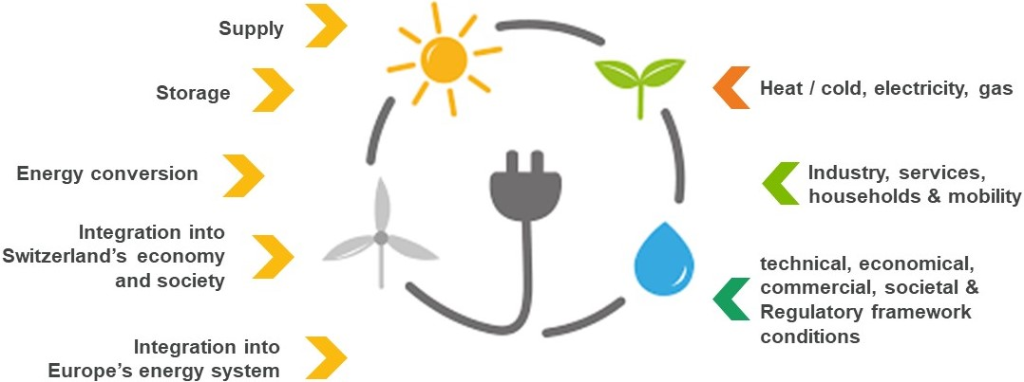Background
PATHFNDR is one of the four selected consortia in the context of the SWEET Call 1-2020 with the guiding theme “Integration of renewables into a sustainable and resilient Swiss energy system”.
PATHFNDR focuses on the research challenge “Improve renewable energy system efficiency through flexibility and sector coupling”. In particular, the consortium addresses this systemic challenge with the overall objective to find feasible pathways towards an efficient, flexible, resilient, cost-effective, and sustainable energy system by resolving the role and opportunities for flexibility options covering all energy carriers across sectors.
Consistent pathways map out the energy transition to 2050 and go beyond classical techno-economic analysis by resolving suitable business models, policies, and public acceptance measures and integrating national and regional perspectives embedded in the European setting.
To do so, the consortium builds on a broad range of existing models, tools and demonstrator platforms as well as qualitative approaches such as case-study research and integrates technical, economic, regulatory, and social disciplines. This methodology will systematically support the transition of solutions into practice. Therefore, the second overall objective of the PATHFNDR consortium is to demonstrate the identified feasible paths by designing, building, operating, and studying two energy systems coupling several energy forms: one by exploiting flexibility options in existing infrastructure, and the other by creating a novel infrastructure for flexibility-enhanced energy systems.
The PATHFNDR consortium aims to answer five central research questions:
- How can an efficient, flexible, resilient, cost-competitive, and sustainable Swiss energy system by 2050 look like?
- What legislative and regulatory frameworks should be adopted to enable the transition to the system identified in the first research question, including the needed incentives for flexibility providers as well as sector coupling?
- Which business models and commercial value propositions should be developed to value needed flexibility and sector coupling?
- What measures are necessary to ensure acceptance and participation of citizens and their organizations?
- How can pilot and demonstration projects of flexible energy systems at the district/village/city scale be best exploited to increase our understanding of technical and socio-economic aspects as well as to trigger wider adoption?

Nexus-e in PATHFNDR
Nexus-e is the central tool for the SWEET consortium to provide scenarios, outlining which pathways are feasible and which ones are potentially problematic, considering technical, economic, and social constraints for the national scale and regional scale. We assess these pathways with respect to efficiency, flexibility, resilience, cost-competitiveness, and sustainability. For this task, Nexus-e is further extended to represent the full energy system in Switzerland. This extension, in particular, focuses on industry and heating, transportation and the gas network, and allows us to conduct the following three assessments.
First, we assess the techno-economic potential of sector-coupling for the industry and heating sector. We consider all industry sectors in terms of energy consumed and supplied, revealing synergies through, e.g., waste heat available for the domestic heating sector. A particular focus will lie on the chemical industry, given its potential for both sector-coupling and flexibility due to its high energy use, waste heat potential, and need for chemical feedstocks that could also serve as energy carriers and/or storage. We consider residential and industrial heating demands and future trends on their corresponding temperature levels as well as a wide range of technology options and heat sources to determine the optimal pathway to decarbonize the heating sector.
Second, we assess the techno-economic potential of transportation in Switzerland for providing flexibility through electrification and sector-coupling. To do so, we represent the evolving demand of electricity, synthetic fuels, and other energy carriers used in transportation in Nexus-e. We consider the possible electrification of transportation (e.g., cars, ferries, trucks) and the pathways for decarbonizing the hard-to-electrify modes of transportation (e.g., shipping, aviation), for example, through sector coupling. We also perform a detailed assessment of the increased flexibility potential and how it benefits the Swiss energy system.
Third, we assess the role of the Swiss gas network in flexibility provision. We consider the use of synthetic gas located in key industrial sites and power-to-gas sites and of gas storage facilities as long- and short-term flexibility providers in connection with their operations within the gas grid. Furthermore, we will investigate whether the deployment of flexibility providers using synthetic gas needs a gas network infrastructure or rather point-to-point pipeline connections linking relevant gas synthesis and consumption sites.
Linking to other modules
A key part of PATHFNDR is also to create synergies between tools and platforms by linking them. Based on the experience of the CH2040 project, in which we already developed a link between Euro-Calliope and Nexus-e (through input/output exchanges), we will continue the collaboration with Calliope and add new ones in the context of PATHFNDR. The table below lists the platforms and tools, with which Nexus-e will develop a link.
For example, for the link with EXPANSE, we will downscale cantonal-level Nexus-e results to assess their implications at the local level with respect to deployment of renewable and flexibility technologies, for example, the required rooftop PV capacities across municipalities, or the required local infrastructure for heating sector transformation. To do this, the existing municipal-scale Expanse model will be extended to include flexibility measures and sector coupling (heat, transport), and to integrate with Nexus-e in a two-way interaction loop.
Tool | Type | Scope | Sectors | Disciplines |
|---|---|---|---|---|
Simulation | Europe | Electricity, Heat, Transportation | Techno-economic | |
Simulation | Regionally resolved | Electricity, Heat | Techno-economic | |
FlexECO | Simulation | Switzerland / Regional | Electricity | Techno-economic |
Demonstrator | Platform integration, Co-simulation host | Electricity, Heat, Gas | - |

